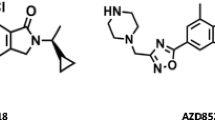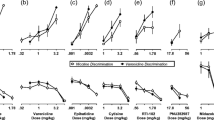Abstract
Rationale
Antagonists acting at the N-methyl-d-aspartate (NMDA) subtype of glutamate receptors inhibit various phenomena associated with exposures to nicotine (e.g., tolerance, sensitization, dependence, and intravenous self-administration). These effects are often discussed in terms of nicotine-induced glutamate release with subsequent glutamate-dependent stimulation of dopamine metabolism and neuronal plasticity in brain areas critically involved in drug-addiction mechanisms. However, it is also well established that certain types of NMDA receptor antagonists (channel blockers) potently bind to nicotinic receptors and may act as nicotinic receptor antagonists.
Objective
The present study aimed to evaluate the discriminative-stimulus effects of the NMDA receptor channel blockers (+)MK-801, dextromethorphan, and memantine in rats trained to discriminate nicotine from its vehicle.
Methods
Adult male Wistar rats were trained to discriminate 0.6 mg/kg nicotine from saline under a two-lever, fixed-ratio 10 schedule of food reinforcement. During test sessions, injections of (+)MK-801 (0.03–0.3 mg/kg, i.p.), dextromethorphan (30 mg/kg, s.c.), or memantine (1–10 mg/kg, i.p.) were co-administered with s.c. nicotine (0.075–0.6 mg/kg; interaction tests) or saline (generalization tests). Additional interaction and generalization tests were conducted with the selective nicotinic receptor antagonists mecamylamine (0.1–3 mg/kg, s.c.) and MRZ 2/621 (0.3–10 mg/kg, i.p.), and the mGlu5 receptor antagonist MPEP (3–10 mg/kg, i.p.).
Results
In generalization tests, none of the compounds produced any appreciable levels of substitution for nicotine. The nicotine discriminative-stimulus control was dose dependently attenuated by mecamylamine (ED50=0.67 mg/kg) and MRZ 2/621 (ED50=9.7 mg/kg). Both agents produced a marked downward shift in the nicotine dose–response curve. Memantine and MPEP slightly attenuated nicotine discriminative-stimulus effects, while (+)MK-801 and dextromethorphan did not affect the nicotine-appropriate responding.
Conclusions
NMDA receptor channel blockers, such as (+)MK-801, dextromethorphan, and memantine, have minimal interactions with the discriminative-stimulus effects of nicotine.



Similar content being viewed by others
References
Bespalov AY, Beardsley PM, Balster RL (1998) Interactions between N-methyl-d-aspartate receptor antagonists and the discriminative stimulus effects of morphine in rats. Pharmacol Biochem Behav 60:507–517
Briggs CA, McKenna DG (1996) Effect of MK-801 at the human alpha 7 nicotinic acetylcholine receptor. Neuropharmacology 35:407–414
Brioni JD, Kim DJ, O’Neill AB (1996) Nicotine cue: lack of effect of the alpha 7 nicotinic receptor antagonist methyllycaconitine. Eur J Pharmacol 301:1–5
Buisson B, Bertrand D (1998) Open-channel blockers at the human alpha4beta2 neuronal nicotinic acetylcholine receptor. Mol Pharmacol 53:555–563
Chavez-Noriega LE, Crona JH, Washburn MS, Urrutia A, Elliott KJ, Johnson EC (1997) Pharmacological characterization of recombinant human neuronal nicotinic acetylcholine receptors h alpha 2 beta 2, h alpha 2 beta 4, h alpha 3 beta 2, h alpha 3 beta 4, h alpha 4 beta 2, h alpha 4 beta 4 and h alpha 7 expressed in Xenopus oocytes. J Pharmacol Exp Ther 280:346–356
Danysz W, Parsons CG, Kornhuber J, Schmidt WJ, Quack G (1997) Aminoadamantanes as NMDA receptor antagonists and antiparkinsonian agents—preclinical studies. Neurosci Biobehav Rev 21:455–468
Fu Y, Matta SG, Gao W, Brower VG, Sharp BM (2000) Systemic nicotine stimulates dopamine release in nucleus accumbens: re-evaluation of the role of N-methyl-d-aspartate receptors in the ventral tegmental area. J Pharmacol Exp Ther 294:458–465
Gasparini F, Lingenhohl K, Stoehr N, Flor PJ, Heinrich M, Vranesic I, Biollaz M, Allgeier H, Heckendorn R, Urwyler S, Varney MA, Johnson EC, Hess SD, Rao SP, Sacaan AI, Santori EM, Velicelebi G, Kuhn R (1999) 2-Methyl-6-(phenylethynyl)-pyridine (MPEP), a potent, selective and systemically active mGlu5 receptor antagonist. Neuropharmacology 38:1493–1503
Gilling KE, Weston A, Jatzke C, Parsons CG, Danysz W (2002) Are the beneficial therapeutic effects of neuronal nicotinic receptor agonists due to activation or inactivation/desensitization of alpha7 and alpha4beta2 receptors. Abstr Soc Neurosci 28, 432.17
Glick SD, Maisonneuve IM, Dickinson HA, Kitchen BA (2001) Comparative effects of dextromethorphan and dextrorphan on morphine, methamphetamine, and nicotine self-administration in rats. Eur J Pharmacol 422:87–90
Glick SD, Maisonneuve IM, Kitchen BA (2002) Modulation of nicotine self-administration in rats by combination therapy with agents blocking alpha 3 beta 4 nicotinic receptors. Eur J Pharmacol 448:185–191
Gommans J, Stolerman IP, Shoaib M (2000) Antagonism of the discriminative and aversive stimulus properties of nicotine in C57BL/6J mice. Neuropharmacology 39:2840–2847
Hernandez SC, Bertolino M, Xiao Y, Pringle KE, Caruso FS, Kellar KJ (2000) Dextromethorphan and its metabolite dextrorphan block alpha3beta4 neuronal nicotinic receptors. J Pharmacol Exp Ther 293:962–967
Homayoun H, Stefani MR, Adams BW, Tamagan GD, Moghaddam B (2004) Functional interaction between NMDA and mGlu5 receptors: effects on working memory, instrumental learning, motor behaviors, and dopamine release. Neuropsychopharmacology 29:1259–1269
Hundt W, Danysz W, Holter SM, Spanagel R (1998) Ethanol and N-methyl-d-aspartate receptor complex interactions: a detailed drug discrimination study in the rat. Psychopharmacology (Berl) 135:44–51
Kantak KM, Edwards MA, O’Connor TP (1998) Modulation of the discriminative stimulus and rate-altering effects of cocaine by competitive and noncompetitive N-methyl-d-aspartate antagonists. Pharmacol Biochem Behav 59:159–169
Koek W, Colpaert FC, Vignon J (1993) Effects of phencyclidine-type drugs in rats discriminating fentanyl from saline: pharmacological and behavioral characterization of intermediate levels of drug lever selection. J Pharmacol Exp Ther 264:746–756
Koek W, Kleven MS, Colpaert FC (1995) Effects of the NMDA antagonist, dizocilpine, in various drug discriminations: characterization of intermediate levels of drug lever selection. Behav Pharmacol 6:590–600
Löscher W, Potschka H, Wlaz P, Danysz W, Parsons CG (2003) Are neuronal nicotinic receptors a target for antiepileptic drug development? Studies in different seizure models in mice and rats. Eur J Pharmacol 466:99–111
Mansbach RS, Chambers LK, Rovetti CC (2000) Effects of the competitive nicotinic antagonist erysodine on behavior occasioned or maintained by nicotine: comparison with mecamylamine. Psychopharmacology (Berl) 148:234–242
Mansvelder HD, McGehee DS (2000) Long-term potentiation of excitatory inputs to brain reward areas by nicotine. Neuron 27:349–357
Mansvelder HD, Keath JR, McGehee DS (2002) Synaptic mechanisms underlie nicotine-induced excitability of brain reward areas. Neuron 33:905–919
Papke RL, Sanberg PR, Shytle RD (2001) Analysis of mecamylamine stereoisomers on human nicotinic receptor subtypes. J Pharmacol Exp Ther 297:646–656
Paterson NE, Semenova S, Gasparini F, Markou A (2003) The mGluR5 antagonist MPEP decreased nicotine self-administration in rats and mice. Psychopharmacology (Berl) 167:257–264
Pulvirenti L, Balducci C, Koob GF (1997) Dextromethorphan reduces intravenous cocaine self-administration in the rat. Eur J Pharmacol 321:279–283
Schilstrom B, Fagerquist MV, Zhang X, Hertel P, Panagis G, Nomikos GG, Svensson TH (2000) Putative role of presynaptic alpha7* nicotinic receptors in nicotine stimulated increases of extracellular levels of glutamate and aspartate in the ventral tegmental area. Synapse 38:375–383
Shoaib M, Benwell ME, Akbar MT, Stolerman IP, Balfour DJ (1994) Behavioural and neurochemical adaptations to nicotine in rats: influence of NMDA antagonists. Br J Pharmacol 111:1073–1080
Stolerman IP, Pratt JA, Garcha HS, Giardini V, Kumar R (1983) Nicotine cue in rats analysed with drugs acting on cholinergic and 5-hydroxytryptamine mechanisms. Neuropharmacology 22:1029–1037
Stolerman IP, Chamberlain S, Bizarro L, Fernandes C, Schalkwyk L (2004) The role of nicotinic receptor alpha 7 subunits in nicotine discrimination. Neuropharmacology 46:363–371
Takayama H, Majewska MD, London ED (1989) Interactions of noncompetitive inhibitors with nicotinic receptors in the rat brain. J Pharmacol Exp Ther 251:1083–1089
Willetts J, Balster RL (1989) Pentobarbital-like discriminative stimulus effects of N-methyl-d-aspartate antagonists. J Pharmacol Exp Ther 249:438–443
Wooltorton JR, Pidoplichko VI, Broide RS, Dani JA (2003) Differential desensitization and distribution of nicotinic acetylcholine receptor subtypes in midbrain dopamine areas. J Neurosci 23:3176–3185
Young R, Glennon RA (2002) Nicotine and bupropion share a similar discriminative stimulus effect. Eur J Pharmacol 443:113–118
Acknowledgements
Supported in part by the Russian Ministry of Health contract no. 010/055/050. The authors thank Dr. F. Gasparini (Novartis Pharma, Switzerland) for the generous gift of MPEP used in this study. The authors are grateful to Mr. Vladimir Kashkin for his excellent technical assistance.
Author information
Authors and Affiliations
Corresponding author
Rights and permissions
About this article
Cite this article
Zakharova, E.S., Danysz, W. & Bespalov, A.Y. Drug discrimination analysis of NMDA receptor channel blockers as nicotinic receptor antagonists in rats. Psychopharmacology 179, 128–135 (2005). https://doi.org/10.1007/s00213-004-2067-4
Received:
Accepted:
Published:
Issue Date:
DOI: https://doi.org/10.1007/s00213-004-2067-4




